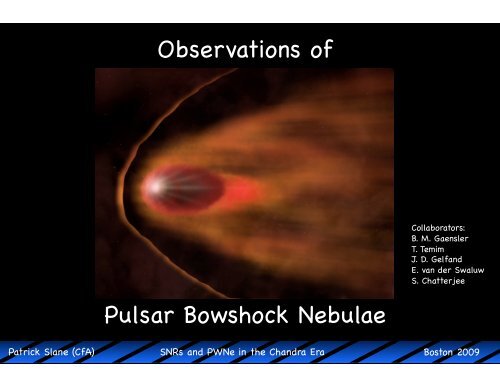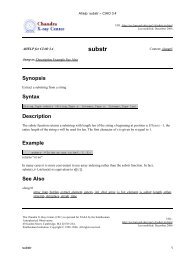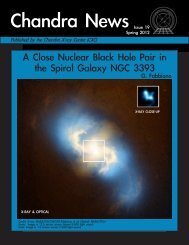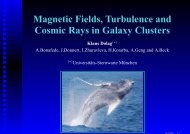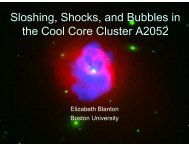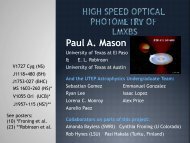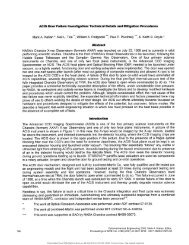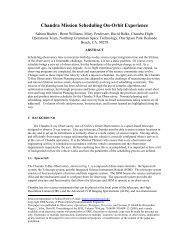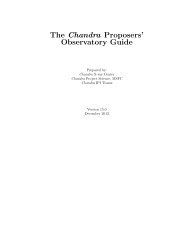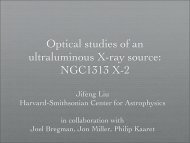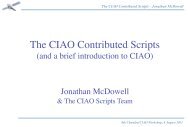Observations of Bow-Shock Pulsar Wind Nebulae - Chandra X-Ray ...
Observations of Bow-Shock Pulsar Wind Nebulae - Chandra X-Ray ...
Observations of Bow-Shock Pulsar Wind Nebulae - Chandra X-Ray ...
You also want an ePaper? Increase the reach of your titles
YUMPU automatically turns print PDFs into web optimized ePapers that Google loves.
<strong>Observations</strong> <strong>of</strong>!<br />
<strong>Pulsar</strong> <strong>Bow</strong>shock <strong>Nebulae</strong>!<br />
Patrick Slane (CfA)! SNRs and PWNe in the <strong>Chandra</strong> Era!<br />
Collaborators:!<br />
B. M. Gaensler!<br />
T. Temim!<br />
J. D. Gelfand!<br />
E. van der Swaluw!<br />
S. Chatterjee!<br />
Boston 2009!
<strong>Bow</strong> <strong>Shock</strong> PWNe: Introduction!<br />
• Formed by supersonic motion <strong>of</strong> pulsar!<br />
through surrounding medium!<br />
- can occur within host SNR or in ISM!<br />
- different Mach numbers lead to different!<br />
morphology!<br />
• Forward shock: stand-<strong>of</strong>f distance defined !<br />
by balance <strong>of</strong> wind with ambient pressure:!<br />
E ˙<br />
= ρ 2 0vPSR 4πωR0 c<br />
2 = γM 2 pamb<br />
• Termination shock – asymmetric!<br />
for M ∼ 1 – 3, R TS B /RTS F ∼ M<br />
for M >> 1, R TS B /RTS F ∼ 5 – 6!<br />
• <strong>Shock</strong>ed ambient material!<br />
- Hα in partially-neutral material!<br />
Patrick Slane (CfA)! SNRs and PWNe in the <strong>Chandra</strong> Era!<br />
forward!<br />
shock!<br />
termination !<br />
shock (front)!<br />
contact!<br />
discontinuity! termination !<br />
shock (rear)!<br />
• <strong>Shock</strong>ed wind: radio/X-ray tail!<br />
Gaensler & Slane 2006!<br />
- broad tail from material shocked at φ ∼ π/2!<br />
- narrow tail from flow along axis!<br />
- tail region broader, TS region smaller for!<br />
low-M shocks (such as within SNRs)!<br />
- Note: for X-ray bow shocks, cometary shape is!<br />
not described by classic Mach cone geometry!<br />
Boston 2009!
<strong>Bow</strong> <strong>Shock</strong> PWNe: Introduction!<br />
• Formed by supersonic motion <strong>of</strong> pulsar!<br />
through surrounding medium!<br />
- can occur within host SNR or in ISM!<br />
- different Mach numbers lead to different!<br />
morphology!<br />
• Forward shock: stand-<strong>of</strong>f distance defined !<br />
by balance <strong>of</strong> wind with ambient pressure:!<br />
E ˙<br />
= ρ 2 0vPSR 4πωR0 c<br />
2 = γM 2 pamb<br />
• Termination shock – asymmetric!<br />
for M ∼ 1 – 3, R TS B /RTS F ∼ M<br />
for M >> 1, R TS B /RTS F ∼ 5 – 6!<br />
• <strong>Shock</strong>ed ambient material!<br />
- Hα in partially-neutral material!<br />
• <strong>Shock</strong>ed wind: radio/X-ray tail!<br />
Patrick Slane (CfA)! SNRs and PWNe in the <strong>Chandra</strong> Era!<br />
PSR J0437-4715!<br />
Fruchter et al.!<br />
- broad tail from material shocked at φ ∼ π/2!<br />
- narrow tail from flow along axis!<br />
- tail region broader, TS region smaller for!<br />
low-M shocks (such as within SNRs)!<br />
- Note: for X-ray bow shocks, cometary shape is!<br />
not described by classic Mach cone geometry!<br />
Boston 2009!
<strong>Bow</strong> <strong>Shock</strong> PWNe in the ISM: The Mouse!<br />
6 arcmin<br />
Gaensler et al. 2004!<br />
Patrick Slane (CfA)! SNRs and PWNe in the <strong>Chandra</strong> Era!<br />
VLA!<br />
• Extremely long PWN produced by!<br />
PSR J1747-2958 (l ∼ 17d 5 pc)!<br />
- observe X-ray/radio emission from!<br />
innermost regions, and long radio tail !<br />
Boston 2009!
Gaensler et al. 2004!<br />
<strong>Bow</strong> <strong>Shock</strong> PWNe in the ISM: The Mouse!<br />
Patrick Slane (CfA)! SNRs and PWNe in the <strong>Chandra</strong> Era!<br />
• Extremely long PWN produced by!<br />
PSR J1747-2958 (l ∼ 17d 5 pc)!<br />
- observe X-ray/radio emission from!<br />
innermost regions, and long radio tail !<br />
• X-ray image shows compact emission!<br />
around pulsar, “tongue” region behind!<br />
pulsar, and extended tail!<br />
- L x /Ė = 0.02!<br />
- tongue corresponds to TS region!<br />
- stand<strong>of</strong>f distance implies M ≥ 60!<br />
#∴ v ≈ 600 km s -1 !<br />
assuming motion through warm ISM!<br />
- consistent w/ R TS B /RTS F > 5 !<br />
• X-ray tail is shocked wind from back!<br />
TS region!<br />
- outer tail shows steeper spectrum!<br />
- long, broad radio tail is combination <strong>of</strong>!<br />
swept-back wind w/ that from behind TS!<br />
Boston 2009!
Gaensler et al. 2004!<br />
Gaensler et al. 2004!<br />
<strong>Bow</strong> <strong>Shock</strong> PWNe in the ISM: The Mouse!<br />
Issues:!<br />
Patrick Slane (CfA)! SNRs and PWNe in the <strong>Chandra</strong> Era!<br />
• Compact “head” <strong>of</strong> X-ray emission!<br />
appears extended!<br />
- should just be the pulsar!<br />
- possibly a pileup effect, or is this !<br />
something similar to clumps seen !<br />
“inside” TS region in Crab and other!<br />
PWNe?!<br />
• Faint halo observed ahead <strong>of</strong> bow!<br />
shock!<br />
- unlikely to be shocked ISM!<br />
- probably dust scattering halo!<br />
• X-ray emission in “tongue” region!<br />
has a “filled” morphology !<br />
- associated with finite thickness due to !<br />
ion gyration, along with Doppler !<br />
beaming!<br />
Boston 2009!
• If pulsar is moving through SNR, it!<br />
will encounter reverse shock first!<br />
in direction <strong>of</strong> motion!<br />
- relic PWN is pushed back from pulsar!<br />
- nebula around pulsar begins being!<br />
swept into a cometary shape !<br />
• SNR temperature drops toward !<br />
outer shell, reducing sound speed!<br />
- for Sedov-phase SNR, pulsar motion!<br />
becomes supersonic at R ≈ 2R s /3 !<br />
- beyond this a true bow shock forms!<br />
Going Supersonic!<br />
van der Swaluw et al. 2004!<br />
Patrick Slane (CfA)! SNRs and PWNe in the <strong>Chandra</strong> Era!<br />
Boston 2009!
• If pulsar is moving through SNR, it!<br />
will encounter reverse shock first!<br />
in direction <strong>of</strong> motion!<br />
- relic PWN is pushed back from pulsar!<br />
- nebula around pulsar begins being!<br />
swept into a cometary shape !<br />
• SNR temperature drops toward !<br />
outer shell, reducing sound speed!<br />
- for Sedov-phase SNR, pulsar motion!<br />
becomes supersonic at R ≈ 2R s /3 !<br />
- beyond this a true bow shock forms!<br />
Going Supersonic!<br />
Patrick Slane (CfA)! SNRs and PWNe in the <strong>Chandra</strong> Era!<br />
van der Swaluw et al. 2004<br />
Boston 2009!
Olbert et al. 2001!<br />
<strong>Bow</strong> <strong>Shock</strong> PWNe in SNRs: G189.22+2.90!<br />
Patrick Slane (CfA)! SNRs and PWNe in the <strong>Chandra</strong> Era!<br />
• G189.22+2.90 is a bow shock PWN!<br />
in IC 443 (t SNR ∼30,000 yr)!<br />
- orientation suggests non-uniform medium !<br />
for SNR (plus “crosswinds” for PWN)!<br />
Boston 2009!
Gaensler et al. 2006!<br />
<strong>Bow</strong> <strong>Shock</strong> PWNe in SNRs: G189.22+2.90!<br />
Patrick Slane (CfA)! SNRs and PWNe in the <strong>Chandra</strong> Era!<br />
• G189.22+2.90 is a bow shock PWN!<br />
in IC 443 (t SNR ∼30,000 yr)!<br />
- orientation suggests non-uniform medium !<br />
for SNR (plus “crosswinds” for PWN)!<br />
• The stand<strong>of</strong>f distance is resolved!<br />
- indicates v ≈230 km s -1!<br />
• “Tongue” feature traces TS region!<br />
M = γ -1/2 R TS B /RTS F ≈ 1.2!<br />
- low Mach number consistent w/ high!<br />
sound speed in SNR interior!<br />
- “tongue” is filled, like in Mouse!<br />
- tail is less elongated and broader than!<br />
that for Mouse, consistent with small M !<br />
• Pressure balance w/ SNR (kT ∼0.2 keV)!<br />
suggests Ė ≈5 × 10 37 erg s -1!<br />
Boston 2009!
PWNe in Transition? G327.1-1.1!<br />
Patrick Slane (CfA)! SNRs and PWNe in the <strong>Chandra</strong> Era!<br />
Temim et al. 2009! • X-ray observations reveal compact!<br />
10”!<br />
120”!<br />
37”!<br />
core at tip <strong>of</strong> radio finger!<br />
- trail <strong>of</strong> emission extends into nebula!<br />
- L x suggests Ė ~ 10 37.3 erg s -1 !<br />
• Compact core is extended, and!<br />
surrounded by cometary structure<br />
- tail extends back toward radio PWN!<br />
• Estimates <strong>of</strong> pressure, velocity, and Ė suggest entire!<br />
TS shock region extent <strong>of</strong> ∼3.5 arcsec!<br />
- similar to extent <strong>of</strong> inner core, but this doesn’t explain!<br />
cometary shape!<br />
• If cometary segment is TS, then R TS B /RTS F > 3.7, suggestive <strong>of</strong> high-Mach number !<br />
- inconsistent w/ being inside SNR…!<br />
• Curious prong-like structures extend in direction opposite the relic PWN!<br />
- nothing seems consistent with a standard bow shock PWN…!<br />
Boston 2009!
Temim et al. 2009!<br />
PWNe in Transition? G327.1-1.1!<br />
Patrick Slane (CfA)! SNRs and PWNe in the <strong>Chandra</strong> Era!<br />
• Overall morphology <strong>of</strong> SNR and PWN!<br />
suggests that an asymmetric reverse !<br />
shock has played a role!<br />
- PWN has apparently been disturbed by RS,!<br />
and is now re-forming around pulsar!<br />
• RS appears to have approached more !<br />
rapidly from the northwest!<br />
- pulsar appears to be traveling northward!<br />
- combination produces <strong>of</strong>fset between NS and!<br />
SNR center, as well as displacement <strong>of</strong> PWN!<br />
• Prong-like structures connect to a bubble!<br />
- appears to be blown by the pulsar into the!<br />
SNR interior, apparently in the region recently!<br />
crossed by the reverse shock<br />
Boston 2009!
• Note that in pre-Sedov!<br />
phase, sound speed is!<br />
lower in reverse shock!<br />
region than in outer!<br />
SNR!<br />
Cruising at the Reverse <strong>Shock</strong>!<br />
contact!<br />
discontinuity!<br />
Patrick Slane (CfA)! SNRs and PWNe in the <strong>Chandra</strong> Era!<br />
van der Swaluw et al. 2001<br />
Boston 2009!
• Note that in pre-Sedov!<br />
phase, sound speed is!<br />
lower in reverse shock!<br />
region than in outer!<br />
SNR!<br />
Cruising at the Reverse <strong>Shock</strong>!<br />
Patrick Slane (CfA)! SNRs and PWNe in the <strong>Chandra</strong> Era!<br />
Boston 2009!
Summary!<br />
I. <strong>Observations</strong> <strong>of</strong> <strong>Bow</strong> <strong>Shock</strong> PWNe!<br />
#- High-resolution studies reveal similar underlying !<br />
structure to static PWNe!<br />
- Morphology provides measure <strong>of</strong> Mach number!<br />
- Knowledge <strong>of</strong> surroundings provides Ė, pulsar velocity!<br />
- Questions remain on detailed structure <strong>of</strong> innermost regions!<br />
II. Transition Objects!<br />
- As pulsars approach supersonic speeds, PWN morphology is distorted!<br />
toward bow shock geometry!<br />
- More modeling required to study the structure in this stage !<br />
III. <strong>Bow</strong> <strong>Shock</strong>s Near the Reverse <strong>Shock</strong>!<br />
- At least some fast pulsars should form bow-shock-like structures!<br />
well inside SNRs, as they pass through the reverse shock!<br />
- This has impact for interpretation <strong>of</strong> pulsar velocities, and!<br />
possibly as a probe <strong>of</strong> ejecta!<br />
Patrick Slane (CfA)! SNRs and PWNe in the <strong>Chandra</strong> Era!<br />
Boston 2009!


